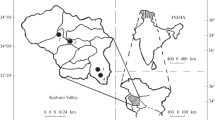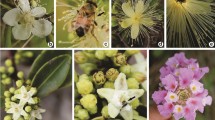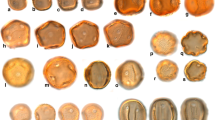Abstract
Transfer of fresh pollen either by wind or by insects is strongly related to the degree of its stickiness. The sticky substances involved should be understood as “pollenkitt”. Ultrastructural investigations indicate that the sticky pollen of entomophilous angiosperms (in this publicationHamamelis vernalis andH. virginiana, Corylopsis platypetala) results from the deposition of usually electron-dense, homogeneous pollenkitt mainly on the outside layer of the exine. In contrast, the pollen of anemophilous angiosperms (in this publicationParrotia persica, Platanus orientalis, Thalictrum flavum andQuercus robur), but also of some entomophilous angiosperms with special pollination ecology (e.g.Aquilegia vulgaris) is rather dry and powdery. In these cases the pollenkitt often is electron-transparent and inhomogeneous and is mainly removed into the cavities of the exine. Ultrastructure and deposition of pollen and pollenkitt in ambophilous angiosperms (in this publicationThalictrum minus, Castanea sativa) are ± intermediate.
Similar content being viewed by others
Literaturverzeichnis
Baum, B. R., Bassett, I. J., Crompton, C. W., 1971: Pollen morphology ofTamarix species and its relationship to the taxonomy of the genus. — Pollen et Spores13, 495–522.
Daumann, E., 1942: Die anbohrbaren Gewebe und rudimentären Nektarien in der Blütenregion. — Beih. Bot. Cbl.61, 11–82.
Daumann, E., 1965: Insekten- und Windbestäubung beiAlisma plantago-aquatica L. — Österr. Bot. Z.112, 295–310.
Daumann, E., 1966: Pollenkitt, Bestäubungsart und Phylogenie. — Novitates Bot. Inst. Bot. Universitatis Carolinae Pragensis1966, 19–28.
Daumann, E., 1969: Zur Blütenmorphologie und Bestäubungsökologie einiger Ranunculaceen (Cimicifuga L.,Actaea L.,Thalictrum L.). — Preslia41, 213–219.
Daumann, E., 1972: Tier-, Wind- und Wasserblütigkeit in der tschechoslowakischen Flora. II. Dicotyledonen. III. Angiospermen zusammenfassend. — Preslia44, 28–36.
Endress, P. K., 1977: Evolutionary trends in theHamamelidales-Fagales-group. — Pl. Syst. Evol. Supp.1, 321–347. Wien-New York: Springer.
Faegri, K., Pijl, L. van der, 1971: The Principles of Pollination Ecology. 2. Aufl. — Oxford: Pergamon Press.
Goldblatt, P., Endress, P., 1977: Cytology and evolution inHamamelidaceae. — J. Arnold Arboretum58, 67–71.
Gronemeyer, W., 1967: Pollenallergie. InHansen, K., Werner, M.: Handbuch der klinischen Allergie, 167–178. — Stuttgart: Thieme Verlag.
Harms, H., 1930:Hamamelidaceae. — InEngler, A., Prantl, K.: Die natürlichen Pflanzenfamilien18a, 303–345. 2. Aufl. — Leipzig: Engelmann.
Hesse, M., 1977: Der Feinbau der Pollenklebstoffe: präparative Probleme bei der Strukturerhaltung, Grundfragen zur Nomenklatur und zur Begriffsabgrenzung. — Linzer Biol. Beiträge9, 181–201.
Hesse, M., 1978a: Entwicklungsgeschichte und Ultrastruktur des Pollenkitts beiTilia (Tiliaceae). — Pl. Syst. Evol.129, 13–30.
Hesse, M., 1978b: Vergleichende Untersuchungen zur Entwicklungsgeschichte und Ultrastruktur von Pollenklebstoffen bei verschiedenen Angiospermen. — Linzer Biol. Beiträge9, 237–258.
- 1978c: Entwicklungsgeschichte und Ultrastruktur von Pollenkitt und Exine bei nahe verwandten entomophilen und anemophilen Sippen:Salicaceae, Tiliaceae undEricaceae. — Flora (im Druck).
- 1978d: Entwicklungsgeschichte und Ultrastruktur von Pollenkitt und Exine bei nahe verwandten entomophilen und anemophilen Sippen:Polygonaceae. — Flora (im Druck).
Hildebrand, F., 1897: Über die Bestäubung beiCyclamen-Arten. — Ber. Deutsch. Bot. Ges.15, 292–298.
Jensen, U., 1968: Serologische Beiträge zur Systematik derRanunculaceae. — Bot. Jahrb. Syst.88, 204–310.
Kaplan, S. M., Mulcahy, D. L., 1971: Mode of pollination and floral sexuality inThalictrum. — Evolution25, 659–668.
Knoll, F., 1930: Über Pollenkitt und Bestäubungsart. — Z. Botanik23, 610–675.
Knoll, F., 1936: Eine Streuvorrichtung zur Untersuchung der Pollenverkittung. — Österr. Bot. Z.85, 161–182.
Knuth, P., 1898: Handbuch der Blütenbiologie2 — Leipzig: Engelmann.
Knuth, P., 1904: Handbuch der Blütenbiologie3 — Leipzig: Engelmann.
Kugler, H., 1970: Blütenökologie. 2. Aufl. — Stuttgart: Gustav Fischer.
Pijl, L. van der, 1960: Ecological aspects of flower evolution, I.: phyletic evolution. — Evolution14, 403–416.
Pohl, F., 1930: Kittstoffreste auf der Pollenoberfläche windblütiger Pflanzen. Untersuchungen zur Morphologie und Biologie des Pollens II. — Beih. Bot. Cbl.46, Abt.A, 286–305.
Pohl, F., 1933: Freilandversuche zur Bestäubungsökologie der Stieleiche. — Beih. Bot. Cbl., Abt.A, 51, 673–692.
Porsch, O., 1950: Geschichtliche Lebenswertung der Kastanienblüte. — Österr. Bot. Z.97, 269–321.
Skvarla, J. J., Larson, D. A., 1965: An electron microscopic study of pollen morphology in theCompositae with special reference to theAmbrosiinae. — Grana Palynologica6, 210–269.
Soepadmo, E., 1972:Fagaceae. InVan Steenis, C.G.G.J., (Ed.): Flora Malesiana7/2, 265–403. — Groningen: Wolters-Nordhoff Publ.
Spurr, A. R., 1969: A low-viscosity epoxy resin embedding medium for electron microscopy. — J. Ultrastr. Res.26, 31–43.
Takhtajan, A., 1959: Die Evolution der Angiospermen. — Jena: VEB Fischer.
Troll, W., 1928: Über Antherenbau, Pollen und Pollination vonGalanthus. — Flora123, 321–343.
Wagenitz, G., 1975: Blütenreduktion als ein zentrales Problem der Angiospermen-Systematik. — Bot. Jahrb. Syst.96, 448–470.
Werth, E., 1923: Über die Bestäubung vonViscum undLoranthus und die Frage der Primitivität der Windblütigkeit wie der Pollenblumen bei den Angiospermen. — Ber. Deutsch. Bot. Ges.41, 151–164.
Whitehead, D. R., 1969: Wind pollination in the Angiosperms: evolutionary and environmental considerations. — Evolution23, 28–35.
Wodehouse, P. R., 1935: Pollen Grains. — New York: McGraw-Hill.
Wodehouse, P. R., 1971: Hayfever Plants. 2. Aufl. — New York: Hafner.
Author information
Authors and Affiliations
Rights and permissions
About this article
Cite this article
Hesse, M. Entwicklungsgeschichte und Ultrastruktur von Pollenkitt und Exine bei nahe verwandten entomophilen und anemophilen Angiospermensippen:Ranunculaceae, Hamamelidaceae, Platanaceae undFagaceae . Pl Syst Evol 130, 13–42 (1978). https://doi.org/10.1007/BF00983072
Received:
Accepted:
Issue Date:
DOI: https://doi.org/10.1007/BF00983072




